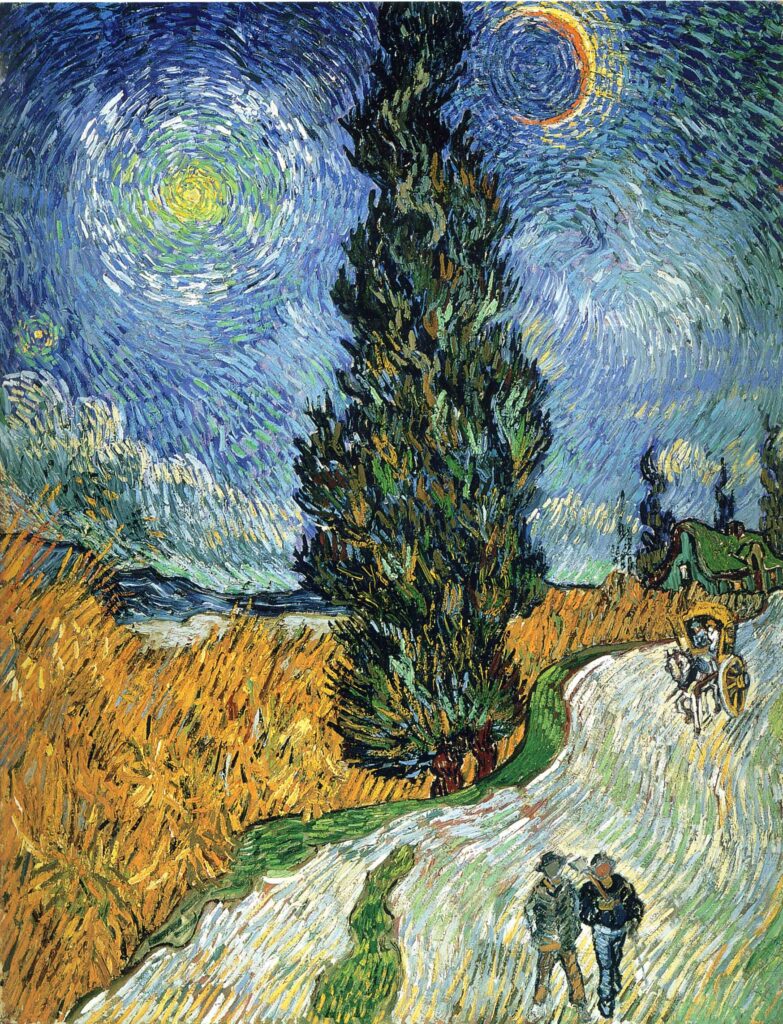Changing Paintings: 47 The cypress tree, and the abduction of Ganymede

After telling the tragedy of Orpheus and Eurydice, Ovid relates a series of shorter myths involving transformations. He introduces these by listing each tree that gave Orpheus shade as he sang in mourning with his lyre, from ash to willow. He then adds two species that were the result of transformations: the Italian pine and cypress. The former he attributes to Attis, who had been consort to Cybele, known to the Romans as the Great Mother goddess.
Ovid’s main story here is of Cyparissus, a youth who had been the love of Apollo. A majestic giant stag had become quite tame in that area, and was a favourite of Cyparissus, who used to lead the stag to pasture, and ride it around on occasion. In the middle of a hot summer’s day, when the stag was asleep, Cyparissus accidentally killed it with his javelin. The youth was heartbroken, and was transformed into a cypress tree. Ever since that tree has grown in and by cemeteries and other places of grief.
Claude-Marie Dubufe (1790–1864), Apollo and Cyparissus (1821), oil on canvas, 188 x 228 cm, Musée Calvet, Avignon, France. Wikimedia Commons.
Surprisingly, this overtly pederastic relationship between Apollo and Cyparissus has been shown in several paintings, of which Claude-Marie Dubufe’s Apollo and Cyparissus (1821) is perhaps an early example. Cyparissus here rests against the stag, but there’s no sign of its wounding or death, although the god is comforting the youth.
Alexander Andreyevich Ivanov (1806–1858), Apollo, Hyacinthus and Cyparissus Making Music and Singing (1834), oil on canvas, 100 × 139.9 cm, The State Tretyakov Gallery Государственная Третьяковская галерея, Moscow, Russia. Wikimedia Commons.
There’s no ambiguity in Alexander Andreyevich Ivanov’s Apollo, Hyacinthus and Cyparissus Making Music and Singing (1834). While Hyacinthus plays the pipes, Apollo embraces Cyparissus. The stag lies sleeping on a rock at the right.
Domenichino (1581-1641) and assistants, The Transformation of Cyparissus (1616-18), fresco transferred from Villa Aldobrandini, Frascati, to canvas and mounted on board, 120 x 88.3 cm, The National Gallery (Bought, 1958), London. Courtesy of and © The National Gallery, London.
By far the most complete depiction of this myth is that painted by Domenichino and his assistants in the Villa Aldobrandini, Frascati, as part of the Stanza di Apollo in its garden pavilion. He has wisely kept the god out of this section of the fresco, and shows the stag dead on the ground, although killed by an arrow rather than a javelin. Next to the animal’s body, a distraught Cyparissus is already changing into a cypress tree.
While considering the cypress as a companion of grief, I cannot ignore the greatest paintings of cypresses of all time, particularly in the context of Vincent van Gogh’s imminent fate.
Vincent van Gogh (1853–1890), Road with Cypress and Star (1890), oil on canvas, 92 x 73 cm, Kröller-Müller Museum, Otterlo. WikiArt.
He may not have known of this myth, but this painting is surely about the grief of Cyparissus, and that of Vincent van Gogh himself.
Orpheus then takes over the narration, telling briefly of Jupiter’s shameful passion for the Trojan prince, Ganymede, and how the god, in the form of an eagle, abducted him to Olympus, where the young man became his cupbearer, to Juno’s evident displeasure.
Ganymede was one of the early citizens of Troy. One day during his youth, he was tending the family flock of sheep near Mount Ida, well inland from the city of Troy, when Jupiter abducted him using an eagle; the bird has been variously described as Jupiter himself or his agent. Ganymede was taken to Mount Olympus, the home of the gods, where he was given eternal youth and immortality, and served as the cupbearer to the gods. Jupiter compensated Ganymede’s father by having Hermes deliver him fine horses.
Leochares (fl 340-320 BCE), Roman copy of bronze original, Ganymede carried off by the eagle (c 325 BCE), marble, height 103 cm, Musei Vaticani, The Vatican City. Image by Jastrow, via Wikimedia Commons.
According to Pliny, writing in his Natural History in 77-79 CE, depictions of the story of Ganymede, and his abduction in particular, changed in about 325 BCE, when Leochares cast a wonderful bronze sculpture showing Ganymede being carried off by an eagle. Sadly the original is long lost, but this marble copy remains in the Vatican.
Michelangelo Buonarroti (1475-1564), copy after, Ganymede (date not known), black chalk on off-white antique laid paper, 36.1 x 27 cm, Harvard Art Museums/Fogg Museum (Gifts for Special Uses Fund), Cambridge, MA. Courtesy of Harvard Art Museums.
This copy of a drawing by Michelangelo (1475-1564) sets the precedent for many later paintings: an eagle as large as, or larger than, Ganymede bears him up to Zeus. Ganymede’s posture is shameless in revealing the purpose of the abduction.
Antonio da Correggio (1490–1534), The Abduction of Ganymede (1520-40), oil on canvas, 163.5 x 72 cm, Kunsthistorisches Museum, Vienna, Austria. Wikimedia Commons.
Correggio’s The Abduction of Ganymede (1520-40) introduces two new features: Ganymede’s dog, left barking at the departing eagle, and the woodland from which he is abducted. The youth looks younger here, and is less flagrantly sexualised.
Rembrandt Harmenszoon van Rijn (1606–1669), Abduction of Ganymede (1635), oil on canvas, 177 x 129 cm, Staatliche Kunstsammlungen Dresden, Dresden, Germany. Wikimedia Commons.
Rembrandt’s Abduction of Ganymede (1635) makes him little older than a large toddler, no longer fitting with the story about him tending the family flocks. His face, though, is wonderfully expressive.
Peter Paul Rubens (1577–1640), The Rape of Ganymede (1636-37), oil on canvas, 181 × 87.3 cm, Museo Nacional del Prado, Madrid. Wikimedia Commons.
Peter Paul Rubens’ The Rape of Ganymede (1636-37) is a surprise in using this story with profane humour, with the placement of both ends of Ganymede’s quiver. Clearly this wasn’t intended for viewing by polite mixed company.
Eustache Le Sueur (1617–1655), The Abduction of Ganymede by Jupiter (1644), oil on canvas, 127 × 108 cm, Musée du Louvre, Paris. Wikimedia Commons.
Le Sueur’s The Abduction of Ganymede by Jupiter (1644) is more respectable, although still not free from pederastic taint.
Nicolaes Maes (1634-1693), Portrait of George Bredehoff de Vicq as Ganymede (date not known), oil on canvas, 99 x 84.5 cm, Harvard Art Museums/Fogg Museum (Kate, Maurice R., and Melvin R. Seiden Purchase Fund in honor of Lisbet and Joseph Leo Koerner), Cambridge, MA. Courtesy of Harvard Art Museums.
Nicolaes Maes, in his Portrait of George Bredehoff de Vicq as Ganymede, must have been extremely naive to have chosen the story for a portrait of an infant.
There followed further paintings of the abduction of Ganymede, although its popularity in narrative painting waned.
Gustave Moreau (1826–1898), The Abduction of Ganymede (1886), watercolour and gouache on paper, 58.5 × 45.5 cm, Private collection. Wikimedia Commons.
Then in 1886, Gustave Moreau painted this watercolour which retold the new version, complete with barking dog and the surrounding wood. With his detailed knowledge of classical times, it’s hard to believe that Moreau didn’t understand its connotation.
Around the start of the twentieth century, Frank Kirchbach made a drawing that was turned into an engraving, and came to inspire still more bizarre connections.
Frank Kirchbach (1859-1912) (after), advertisement for Budweiser beer after ‘The Rape of Ganymede’ (1904), advertisement in Theatre magazine, February 1906.
In 1904, Kirchbach’s print was borrowed for an advertisement for Budweiser beer. The advertiser’s ‘modern vision of Ganymede’ is taken almost directly from Leochares sculpture of 325 BCE, over two millennia earlier. It’s hard to believe that no one recognised its associations with pederasty, then becoming known as paedophilia and recognised for the crime that it is today.




